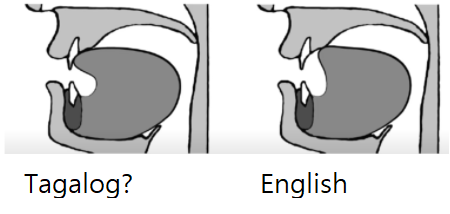To attempt an answer (while awaiting akosikoneho), not only position but aspiration is a component of their pronunciation. From A Tagalog Reference Grammar section 1.4 Voiceless stops : The Tagalog phonemes /p/. /t/, and /k/ differ from their English counterparts ... in several ways. In the first place, the English phonemes have ASPIRATED allophones which occur at the beginning of stressed syllables, while the Tagalog phonemes are UNASPIRATED in all positions.
In addition to the consistent absence of aspiration, two of the Tagalog stops, /t/ and /k/, differ from their English counterparts in point of articulation as well. Tagalog /t/ is dental. while English /t/ is alveolar. Tagalog /t/ is never voiced, regardless of its position in a word.

From section 1.15 Voiced stops : Tagalog /b/, /d/, and /g/ are the voiced counterparts of /p/, /t/, and /k/ respectively, and have the same points of articulation. Just as in the case of the voiceless stops, two of the Tagalog voiced stops, /d/ and /g/, differ in point of articulation from the corresponding English phonemes. Tagalog /d/ is dental while English /d/ is alveolar. In final position, the voiced stops, like their voiceless counterparts, are either unreleased or nasally released.
From section 1.16 Nasals : Tagalog /n/ is dental, while English /n/ is alveolar.
From section 1.19 Lateral : Tagalog /I/ has two allophones: an alveolar lateral, pronounced with the tongue tip against the alveolar ridge, and a dental lateral, pronounced with the tongue tip against the inner surface of the upper teeth. The dental allophone occurs only after the dental stops /t/ and /d/, as in tatlo /tatloh/ 'three', kidlat /kidlat/ 'lightning'; the alveolar allophone occurs elsewhere.
Tagalog /I/, whether alveolar or denial, is of the type called CLEAR [l] , a label used for an [l] sound during which the blade and front of the tongue are raised toward the hard palate. American English /l/, on the other hand, is normally of the type called DARK [l] . a label used for an [l] sound during which the back of the tongue is raised toward the velum.









